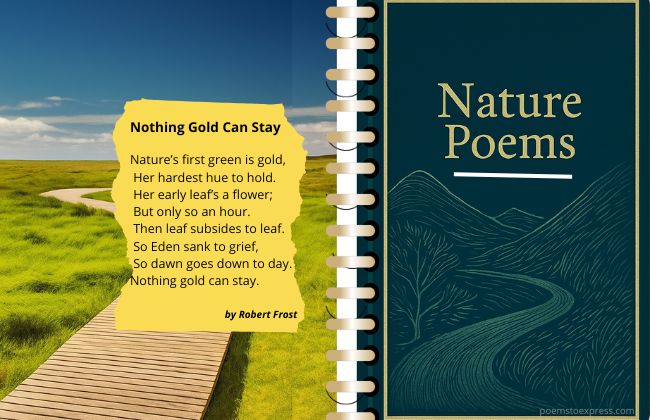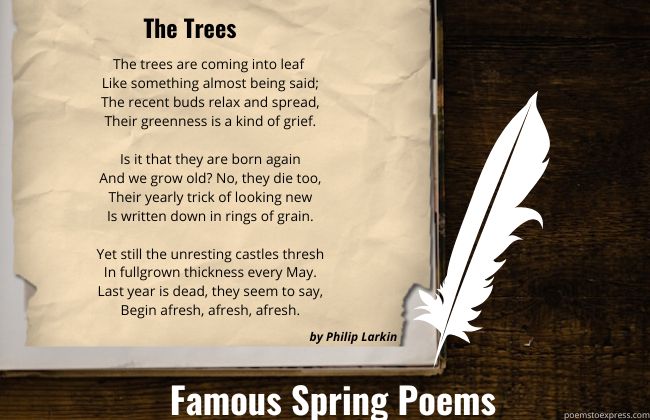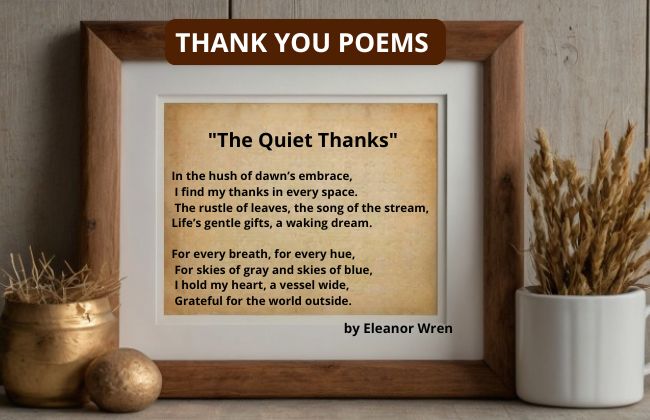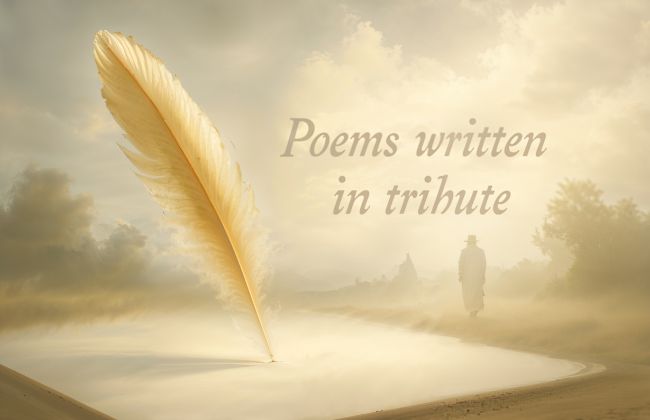Concrete poems, also known as shape poems, are a unique blend of visual art and poetry that use the layout of words to create a specific form or image related to the theme of the poem.
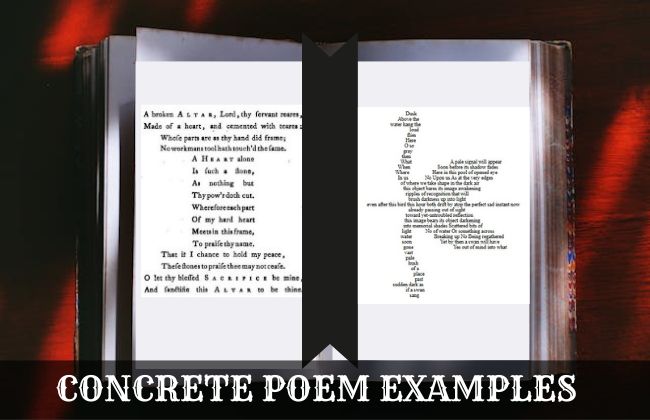
This art form allows poets to express their ideas not only through language, but also through visual representation, enhancing the emotional and aesthetic impact of their work.
With origins dating back to the early 20th century, concrete poetry has evolved into a diverse art form that has been embraced by poets around the world.
From traditional forms to contemporary expressions, these poems invite readers to interact with the text in a dynamic way.
In this post, we will explore 12 of the best examples of concrete poems, highlighting their various styles and themes.
Table of Contents
- 1 What is a Concrete Poem?
- 2 1) “The Mouse’s Tale” by Lewis Carroll
- 3 2) “Easter Wings” by George Herbert
- 4 3) ‘A Pair of Wings’ by Stephen Hawes
- 5 4) “Swan and Shadow” by John Hollander
- 6 5) “Vision and Prayer” by Dylan Thomas
- 7 6) ‘This Crosstree Here’ by Robert Herrick
- 8 7) “The Altar” by George Herbert
- 9 8) ‘Tattoo’ by Wallace Stevens
- 10 9) ‘Silencio’ by Eugen Gomringer
- 11 10) [O sweet spontaneous] by E. E. Cummings
- 12 Historical Context and Evolution of Concrete Poetry
What is a Concrete Poem?
A concrete poem, also known as visual or shape poetry, is a type of poetry where the visual arrangement of the text is as important as the words themselves.
Unlike traditional poetry, which relies primarily on the meaning and sound of words, concrete poetry emphasizes the physical form of the text to convey its message.
The words, letters, and lines are arranged in shapes or patterns that reflect the poem’s subject, creating a visual representation that enhances the reader’s experience.
1) “The Mouse’s Tale” by Lewis Carroll
“The Mouse’s Tale” by Lewis Carroll is a prime example of concrete poetry. This unique poem appears in “Alice’s Adventures in Wonderland.” Carroll cleverly arranges the text to mimic the shape of a mouse’s tail.
The poem is known for its humor, employing a pun on the word “tale” as the mouse narrates its “long and sad tale.” The playful design contributes to its charm.
Readers are drawn into both the visual aspect and the entertaining narrative, showcasing Carroll’s imaginative style in storytelling and poetry.
The Mouse's Tale
"Fury said to
a mouse, That
he met
in the
house,
'Let us… See full poem
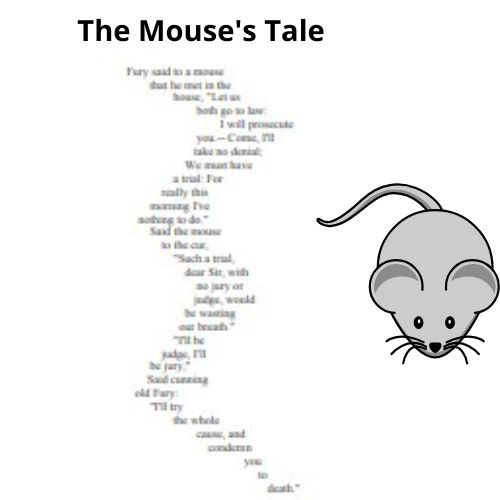
2) “Easter Wings” by George Herbert
This poem stands out due to its unique shape, mimicking wings when viewed sideways. This visual aspect enhances its thematic exploration of spiritual ascent and renewal.
The poem consists of two stanzas, each reflecting the Christian concept of redemption.
Herbert employs a structure that visually represents the expansion and contraction of wings, effectively mirroring the journey from despair to hope.
Easter Wings
Lord, who createdst man in wealth and store,
Though foolishly he lost the same,
Decaying more and more,
Till he became… See full poem
3) ‘A Pair of Wings’ by Stephen Hawes
Stephen Hawes’ poem “A Pair of Wings” is one of the earliest examples of concrete poetry in English, where the visual form of the poem complements its content.
Through its unique structure, with lines that can be read in multiple ways, Hawes explores themes of suffering and redemption.
The poem reflects a mix of devotion and spiritual introspection, inviting the reader to consider the multiple layers of meaning.
Hawes, a poet from the Tudor period, uses this poem to express a deep sense of spiritual introspection and personal quest
A Pair of Wings
See
Me (kinde
Be
Againe
My paine (in minde
Retaine
My swete bloode
On the Roode (my brother
Dide thee good… See full poem
4) “Swan and Shadow” by John Hollander
“Swan and Shadow” by John Hollander is a notable example of concrete poetry. The poem is crafted to visually depict a swan gliding across the water with its reflection below.
Hollander’s work intricately combines visual art and poetry. The layout enhances the exploration of themes like duality and reflection.
The unique form of the poem is not just aesthetic but integral to its meaning. It showcases the harmony between the textual content and its visual presentation.
Swan and Shadow
Dusk
Above the
water hang the
loud
flies
Here
O so
gray… See full poem

5) “Vision and Prayer” by Dylan Thomas
The poem oscillates between questions of identity and existence, using vivid imagery that reflects on the profound moments of birth and the innate innocence of a child.
The structure of the poem itself—organized visually to represent a diamond shape on the page—mirrors the thematic focus on transformation and spiritual seeking.
This design is not just a stylistic choice but deepens the reader’s engagement with the text as it requires active interpretation and engagement with its form and content.
Vision and Prayer
i
W h o
A r e y o u
Who is born
In the next room
So loud to my own
That I can hear … See full poem
6) ‘This Crosstree Here’ by Robert Herrick
Robert Herrick’s poem “This Crosstree Here” deeply explores the crucifixion of Jesus Christ, employing a concrete or shape poem structure to reinforce its spiritual message. Herrick arranges the poem’s lines to form the image of a cross, symbolically representing suffering and redemption.
The poem reflects on the sacrificial nature of Jesus and its impact on humanity, invoking a sense of urgency and spiritual devotion.
Herrick invites readers to contemplate the profound spiritual significance of the crucifixion, and through its unique format, provides a contemplative experience that reinforces the emotional and theological impact of the narrated event.
‘This Crosstree Here’
This crosstree here
Doth Jesus bear,
Who sweet'ned first
The death accurs'd…. See full poem
7) “The Altar” by George Herbert
“The Altar” by George Herbert is a notable example of a concrete poem, where the text’s layout mirrors the form of an altar. This visual representation reinforces the poem’s spiritual themes and emphasis on devotion.
Written by Herbert, an Anglican priest and poet in the 17th century, “The Altar” combines religious imagery with personal reflection.
The poem uses its shape to symbolize a spiritual altar, highlighting the poet’s heart as a site of sacrifice and worship.
Herbert’s use of the altar shape is a significant artistic choice, reflecting the Baroque style prevalent at the time.
The Altar
A broken ALTAR, Lord, thy servant rears,
Made of a heart and cemented with tears:
Whose parts are as thy hand did frame;
No workman's tool hath touch'd the same… See full poem
8) ‘Tattoo’ by Wallace Stevens
Wallace Stevens’ poem “Tattoo” is a profound exploration of art and imagination, rich in symbolism and metaphor.
The poem delves into how art, symbolized by a tattoo, can leave a lasting impact on the mind, transforming ordinary perception into something extraordinary.
It discusses the relationship between reality and imagination, suggesting that imagination has the power to alter reality and give it new meaning. Additionally, the poem reflects on love and loss, highlighting how love is a transformative force that can change everything, even in the face of loss and sorrow
Tattoo
The light is like a spider.
It crawls over the water.
It crawls over the edges of the snow.
It crawls under your eyelids
And spreads its webs there--
Its two webs… See full poem
9) ‘Silencio’ by Eugen Gomringer
Eugen Gomringer’s poem “Silencio” is a seminal work of concrete poetry, emphasizing the visual arrangement of the word “silencio” to evoke the concept of silence itself.
The poem’s structure, with the word repeated in a block form, creates a powerful visual and conceptual impact. It plays with the paradox of expressing silence through the written word, which inherently contradicts the silence it aims to portray.
Gomringer’s work is deeply influenced by his interest in the simplicity and purity of form, reflecting a minimalist approach where less is more, and the layout of words enhances their meaning.
‘Silencio’
silence silence silence
silence silence silence
silence silence
silence silence silence
silence silence silence
10) [O sweet spontaneous] by E. E. Cummings
The poem uses an extended metaphor to explore the relationship between nature and human attempts to understand it through philosophy, science, and religion.
Cummings personifies the Earth as a beautiful woman and portrays these disciplines as men who try, unsuccessfully, to master her mysterious and spontaneous essence.
The poem suggests that, despite these attempts, nature remains untamed and mysterious, responding only with the beauty of spring.
[O sweet spontaneous]
O sweet spontaneous
earth how often have
the
doting… See full poem
Historical Context and Evolution of Concrete Poetry
Concrete poetry has roots stretching back to ancient times. Its modern incarnation began in the early 20th century, with figures like Guillaume Apollinaire leading the charge.
His work, including the famous collection Calligrammes, utilized typography to form images, setting a precedent for future poets. Over decades, poets have explored and expanded the boundaries of this form, influenced by movements like Dadaism and Surrealism.
Today, concrete poetry continues to evolve, with digital platforms giving it new dimensions. These shifts highlight the adaptability and enduring appeal of blending text with visual artistry.
You might also like:

